Table of Contents
- Mimics as super-organisms
- The life-cycle of a Mimic
- Interplanetary Darwinian evolution
- Speeding up evolution with intelligence
- Regulated evolution versus natural selection
Last week I rewatched one of my favourite movies - Edge of Tomorrow. Although the premise is pretty standard sci-fi action movie stuff (stopping an alien invasion) I have always liked the weird time travel thing going on.
But this time around it wasn't the time-bending physics that I was thinking about, it was the alien or Mimic biology. Here's the scene that made me start to think (minor spoilers ahead):
Mimics as super-organisms
In this scene, the resident mad scientist character and Mimic biologist, Dr. Carter, explains that we should really think of the alien Mimics not as a species, but as a single organism.
This is very reminiscent of thinking of eusocial insects (like ants and bees) and human societies as single super-organisms. Mimics, much like bee colonies with their queen, workers and drones, also come in three types:
- The Drones which are the limbs or the claws of the super-organism. This is the equivalent of worker bees who do all the work to make honey for the bee-colony. Except, Mimic Drones specialise in killing humans, not making honey.
- The Omega which is the brain of the super-organism. It is telepathically connected to all the Mimics and also has the ability to reset the day which gives Edge of Tomorrow its motto: Live. Die. Repeat. I won't talk at all about the biology of resetting the day, I'll leave that to the physicists.
- The Alphas which are the central nervous system. They relay information between the Omega, the Drones and the outside world. They are also much rarer than the Drones. Dr. Carter estimates that 1 in 6.18 million Mimics is an Alpha.
Side note: those digits are a hint at the golden ratio (φ=1.618...) which is a little over-hyped. But on top of that, the maths is also wrong because 1/6,180,000 is not the golden ratio. It just looks like that because of our base-10 system. I doubt these Mimics also have 10 tentacles to count on, but I'm getting sidetracked.
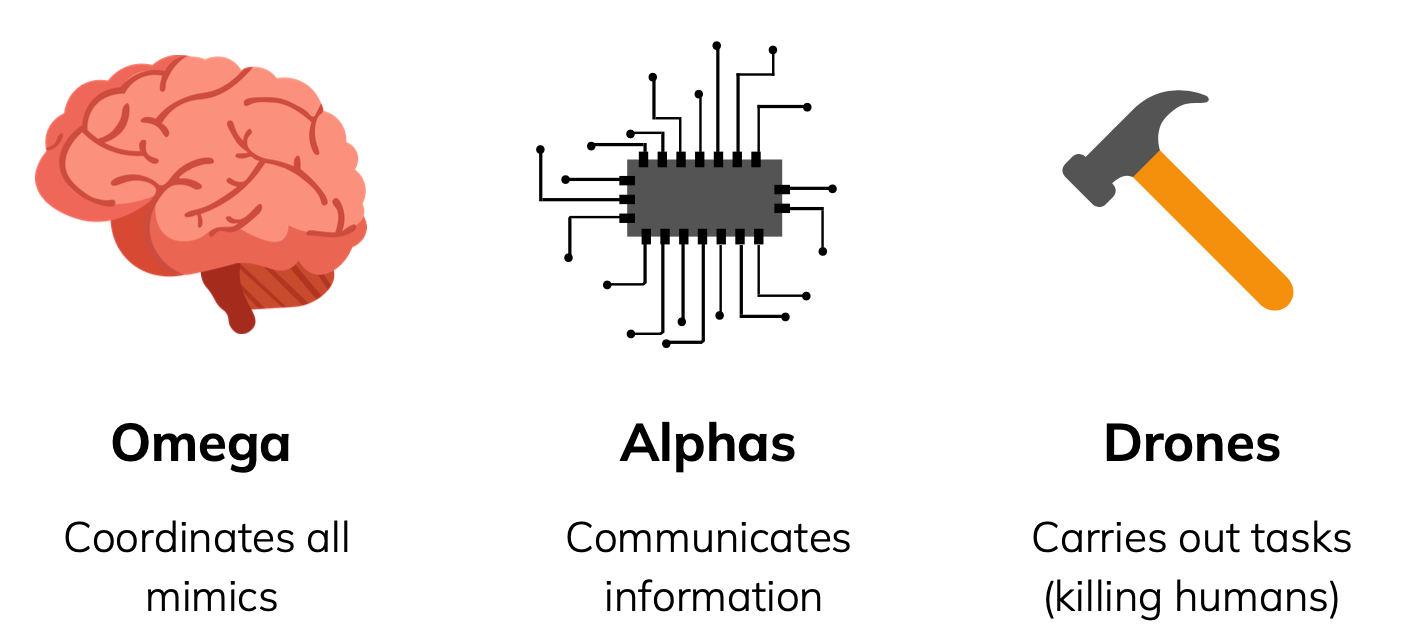
There is one phrase of Dr. Carter's in here that really stands out to me:
This is a perfectly evolved, world-conquering organism.
So naturally the question is, how did Mimics evolve?
The life-cycle of a Mimic
Let's roll back the clock step-by-step on the Mimics and see how far we get. Dr. Carter gives a clue to start with:
There could be thousands, millions of those asteroids floating around in the cosmos like a virus.
This hypothesis actually makes a lot of sense from a classical evolutionary standpoint. Spreading out on asteroids is a form of reproduction. Each time the Mimics spread from their original home planet to another asteroid, they are in some sense replicating.
This may seem a little far fetched, but if you think of planets or asteroids as equivalents to cells, then the comparison is a bit more apt. I've already discussed growth versus reproduction debate in another article so I won't unearth that mess here.
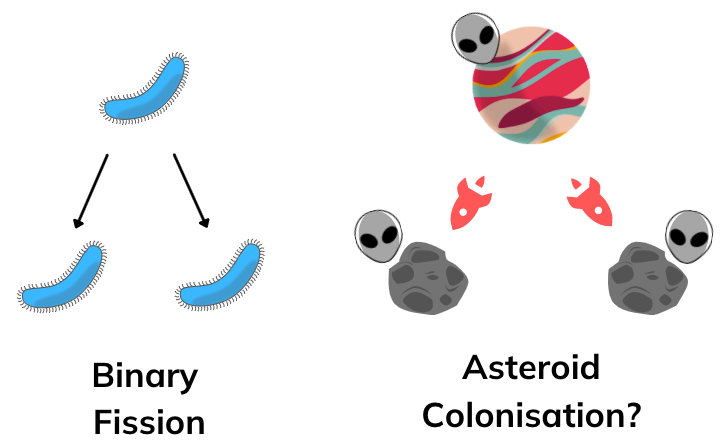
But can these asteroids replicate again or are they a dead end? That is, are the Mimics just sending themselves on these asteroids out into the void, never to be seen again (much like the Voyager spacecrafts)?
That wouldn't be very logical.
Again, Dr. Carter gives us another clue. He hints that Mimics are like a virus not like a cell as I've shown in the diagram above.
Perhaps this is looking a little too closely. But I don't think it would be too far-fetched to say the life cycle of a Mimic-asteroid would look something like this:
- Leave Mimic home planet on an asteroid.
- Invade susceptible planet (e.g. Earth), kill any competing life-forms, and take over as the dominant species.
- Use the planet's resources to produce more Mimic-asteroids.
- Repeat steps 2-3.
Except for the first step, this life cycle is identical to that of a virus. Just on the scale of planets and asteroids instead of cells and proteins. Taking over your cells and turning them into virus-making factories is exactly how COVID lives its 'life' (or SARS-Cov-2 to be precise).
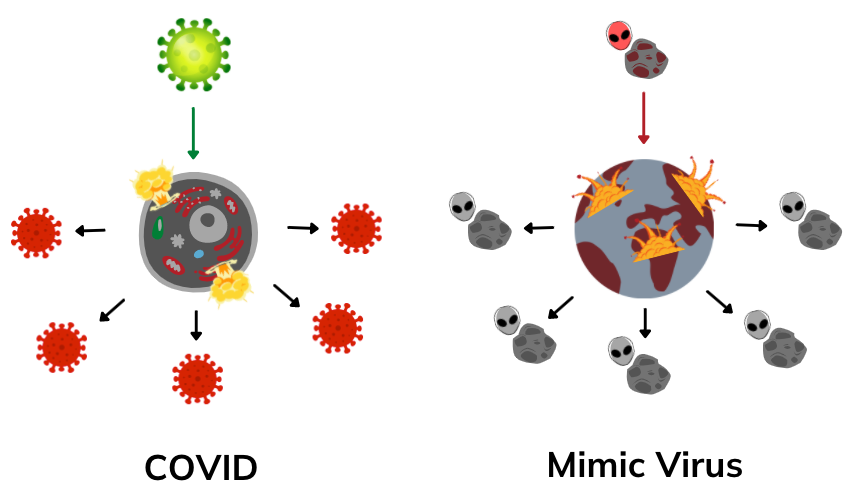
Interplanetary Darwinian evolution
With this description of the Mimic life-cycle there is plenty of room for Darwinian natural selection. Asteroids containing Mimics that are better interplanetary colonisers, will tend to invade more planets, and convert more planets into Mimic-making factories. And asteroids that contain weaker Mimics, are just wiped out.
This is standard natural selection.
This process also likely favours the evolution of aggression. Since more aggressive Mimics are more likely to be successful at overtaking a planet. The diplomatic Mimics that were less aggressive probably either died out, or just exist somewhere else in the universe.
For evolution to come up with stuff like this via natural selection, it takes millions, if not billions of years. We've seen this on Earth too, just with less blasting and shooting and more, well, chomping:
However, this analysis so far is somewhat naïve and misses the important fact that Mimics are a highly intelligent species. Intelligent enough to both reset the day and to be interplanetary travellers.
Speeding up evolution with intelligence
Once intelligence evolves to a sufficient capacity in a species, biological evolution can be kicked into overdrive. To the extent that the species in question no longer needs to rely on genetic information alone to evolve adaptions to their environment.
A nice example of this would be the evolution of the mobile phone. In 50 years alone, mobile phone tech has advanced at a ridiculously fast rate:
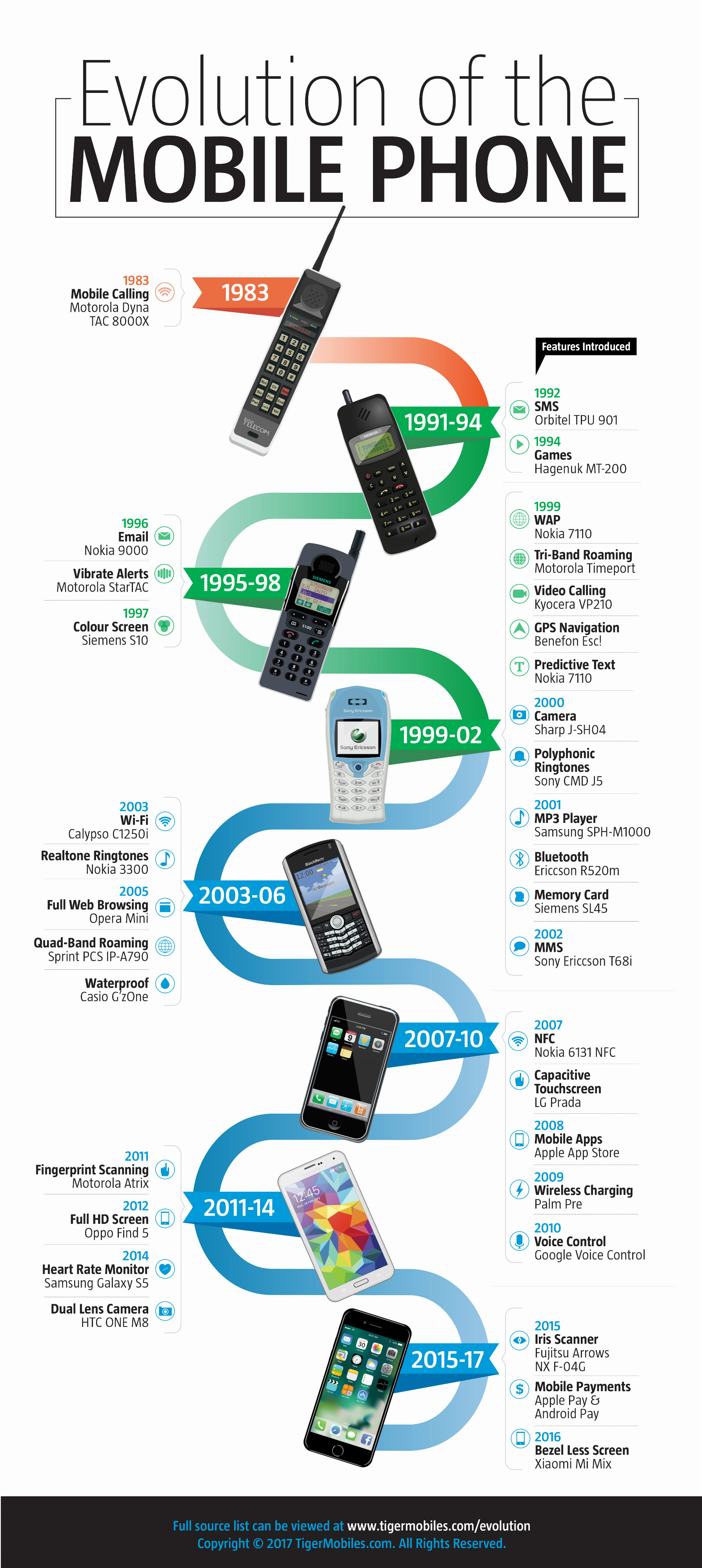
This amount of evolution, at this rate, would be near unthinkable via natural selection alone.
Of course, developing technology occurs via an alternate mechanism, dare I call it intelligent design. To avoid the connotations, I'll refer to this kind of evolution as regulated evolution instead, and I'll explain why in a second.
For phones, a simplified version of the evolutionary process occurs something like this:
- A phone is developed by a company using knowledge of previous technology and other information.
- The phone is released onto the market for consumers.
- The economic success of the phone is monitored by the company and this information is stored for future use.
- Technological advances in other fields are integrated into new phones and constant research may be conducted by the company for future phone innovation.
- Repeat steps 1-4.
This kind of regulated evolution can occur whenever there is intentional control of the information that is passed from generation to generation.
In the case of phones, for evolution to occur, no phones actually need to get produced at all. At least, their production is not necessary to fuel the development. Rather, technological advances in other sectors (e.g. cameras/screens/software) can be used to build better phones.
In the case of Mimics, a similar thing may have occurred. Rather than natural selection just waiting around to see which Mimics are the best assailants, there can be direct regulation of their military strategy.
For instance, maybe they work out that attacking in formation is more effective than attacking as an amorphous horde. This information can be stored (probably in the Omega) and used in the next invasion, as they leave on the asteroids.
In this way, the act of trans-generational learning rapidly speeds up evolution. And this form of regulated evolution has likely driven the Mimics to become as aggressive as we see in the movie. How can we possible know this? Because that's how our own militaries have evolved here on Earth.
Although it can be argued that some natural selection has occurred among armies (between those that win/lose battles), the vast majority of military advances have come through regulated evolution. Armies study previous battles, integrate new technology like nuclear weapons into their arsenals and undergo rigorous training, all of which contributes to the regulated evolution of the army.
It is not too hard to see that regulated evolution is much more efficient and effective than natural selection but this still leaves two questions:
- Why is it more efficient?
- When can regulated evolution occur?
Regulated evolution versus natural selection
We can answer both of these questions by formalising both of these processes into abstract information flows:
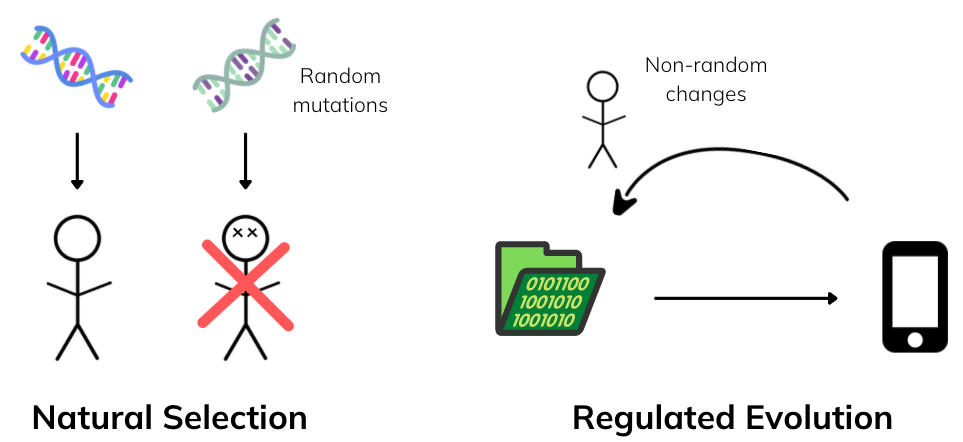
The answer to the first question has two equally important parts.
First, in regulated evolution changes are not random. In standard natural selection, you might have to wait hundreds of thousands of years for just the right beneficial mutation to crop up to evolve a particular via natural selection. In regulated evolution, someone (a Mimic or a human depending on the case) can just go into the source information and change it to get the desired trait. For instance, integrating a camera into a phone.
Second, in regulated evolution, these changes can be immediately implemented across the board. For Mimics this means that all the different Mimic-asteroids might be able to talk to each other, and share information. This way, they could develop working strategies faster, perhaps favouring the evolution of aggression. For phone companies, they can similarly change the software on all of their phones with one simple software update.
In natural selection, this is way way slower. For a beneficial mutation to get implemented population wide (or become fixed in genetic-speak) you have to clear out all of the old-version of the mutation. This requires everyone with the faulty trait dying out. And if the trait is only slightly detrimental compared to the new mutation (e.g. lactose intolerance in humans) that might take hundreds, if not thousands of years.
That being said, natural selection often occurs alongside regulated evolution. For instance, when a new iPhone comes out, the old one tends to get neglected as it is an inferior product to the new one. So whilst the innovation has come through regulated evolution, the removal of the old version occurs via (a primitive form of) natural selection.
Change is still rapid though because of how much better new phones are to old ones; old phones are significantly worse and are therefore pretty quickly purged by a kind of natural selection.
The same could conceivably occur in Mimics. Aggression is favoured by regulated evolution (sharing of military strategy + prior learning) and natural selection then weeds out anyone who stays with the old strategy of diplomacy and playing nice with the humans or other life-forms.
The answer to the second question requires a blog post of its own. But in short, regulated evolution can only occur when modification of the source code of the organism in question is possible, in a non-random manner. This can actually happen without a human hacker or equivalent but I'll leave that discussion for another time.
For the Mimics, they would need some baseline of intelligence to know how to modify the source code that controls their behaviour and learn what works and what doesn't when invading new planets.
Kinda scarily, we have already evolved the capacity to do this with our big brains and our constantly evolving computers. We just don't quite have the rocket-power yet.
So then if we roll back the clock on the Mimics to just before they leave their home planet for the first time, we get an alien species that resembles our civilisation today.
Hopefully we're not on the terrifying life-form conquering, interplanetary species path though. But I'd definitely like to see the interplanetary bit get fulfilled. Maybe we'd be more diplomatic?
Jake


Member discussion: